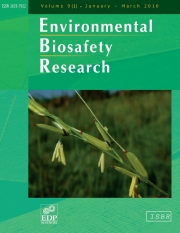Crossref Citations
This article has been cited by the following publications. This list is generated based on data provided by
Crossref.
PAPARINI, ANDREA
and
ROMANO-SPICA, VINCENZO
2006.
Gene Transfer and Cauliflower Mosaic Virus Promoter 35S Activity in Mammalian Cells.
Journal of Environmental Science and Health, Part B: Pesticides, Food Contaminants, and Agricultural Wastes,
Vol. 41,
Issue. 4,
p.
437.
EHRENFELD, DAVID
2006.
Transgenics and Vertebrate Cloning as Tools for Species Conservation.
Conservation Biology,
Vol. 20,
Issue. 3,
p.
723.
Myhre, Marit R.
Fenton, Kristin A.
Eggert, Julia
Nielsen, Kaare M.
and
Traavik, Terje
2006.
The 35S CaMV plant virus promoter is active in human enterocyte-like cells.
European Food Research and Technology,
Vol. 222,
Issue. 1-2,
p.
185.
Squires, Julie
Stephens, Jennifer
Shoelz, James E.
and
Palukaitis, Peter
2007.
Assessment of CaMV-mediated gene silencing and integration of CaMV into GM plants with a 35S RNA promoter.
Environmental Biosafety Research,
Vol. 6,
Issue. 4,
p.
259.
Ho, Mae-Wan
and
Cummins, Joe
2009.
New evidence links CaMV 35S promoter to HIV transcription.
Microbial Ecology in Health and Disease,
Vol. 21,
Issue. 3-4,
p.
172.
Dona, Artemis
and
Arvanitoyannis, Ioannis S.
2009.
Health Risks of Genetically Modified Foods.
Critical Reviews in Food Science and Nutrition,
Vol. 49,
Issue. 2,
p.
164.
Rizzi, Aurora
Raddadi, Noura
Sorlini, Claudia
Nordgrd, Lise
Nielsen, Kaare Magne
and
Daffonchio, Daniele
2012.
The Stability and Degradation of Dietary DNA in the Gastrointestinal Tract of Mammals: Implications for Horizontal Gene Transfer and the Biosafety of GMOs.
Critical Reviews in Food Science and Nutrition,
Vol. 52,
Issue. 2,
p.
142.
Shaheen, Tayyaba
Irem, Samra
and
Zafar, Yusuf
2015.
CO2 Sequestration, Biofuels and Depollution.
Vol. 5,
Issue. ,
p.
307.
Seternes, Tore
Tonheim, Tom C.
Myhr, Anne I.
and
Dalmo, Roy A.
2016.
A plant 35S CaMV promoter induces long-term expression of luciferase in Atlantic salmon.
Scientific Reports,
Vol. 6,
Issue. 1,
Nawaz, Muhammad Amjad
Mesnage, Robin
Tsatsakis, Aristides M.
Golokhvast, Kirill S.
Yang, Seung Hwan
Antoniou, Michael N.
and
Chung, Gyuhwa
2019.
Addressing concerns over the fate of DNA derived from genetically modified food in the human body: A review.
Food and Chemical Toxicology,
Vol. 124,
Issue. ,
p.
423.
Amack, Stephanie C.
and
Antunes, Mauricio S.
2020.
CaMV35S promoter – A plant biology and biotechnology workhorse in the era of synthetic biology.
Current Plant Biology,
Vol. 24,
Issue. ,
p.
100179.
Khosravi, Solmaz
Schindele, Patrick
Gladilin, Evgeny
Dunemann, Frank
Rutten, Twan
Puchta, Holger
and
Houben, Andreas
2020.
Application of Aptamers Improves CRISPR-Based Live Imaging of Plant Telomeres.
Frontiers in Plant Science,
Vol. 11,
Issue. ,
Pouresmaeil, Mahin
Dall’Ara, Mattia
Salvato, Maria
Turri, Valentina
and
Ratti, Claudio
2023.
Cauliflower mosaic virus: Virus-host interactions and its uses in biotechnology and medicine.
Virology,
Vol. 580,
Issue. ,
p.
112.
Azizi-Dargahlou, Shahnam
Pouresmaeil, Mahin
and
Ahmadabadi, Mohammad
2024.
Tobacco Plant: A Novel and Promising Heterologous Bioreactor for the Production of Recombinant Bovine Chymosin.
Molecular Biotechnology,
Vol. 66,
Issue. 9,
p.
2595.


